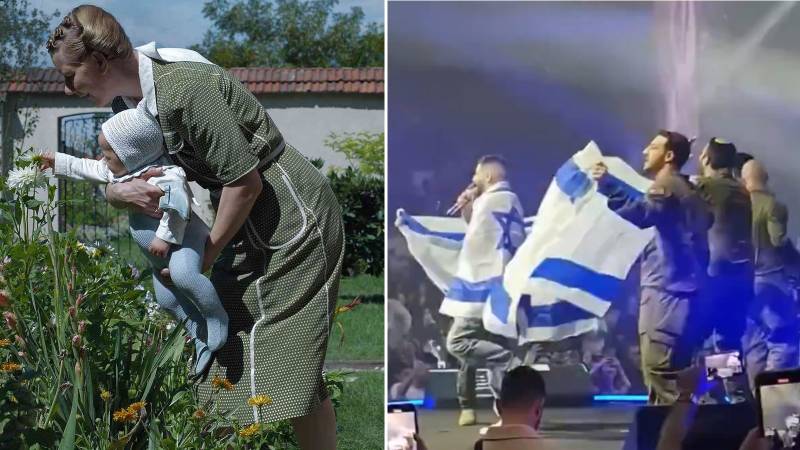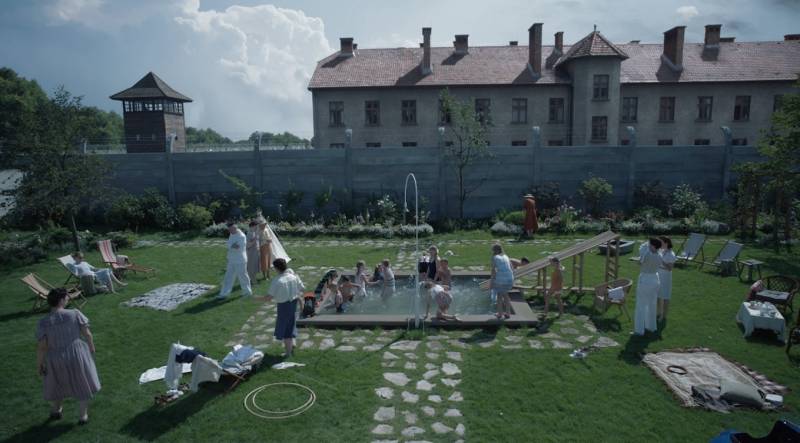
“Do you still not see or understand? Are your hearts hardened? Do you have eyes but fail to see, and ears but fail to hear? And don’t you remember?” (Mark 8:17-18). This fragment of the Bible probably describes Jonathan Glazer's latest film in the simplest way, but it is a much deeper work worth analysing.
The Zone of Interest, because this is the film we are talking about, was nominated for five Oscars and three Golden Globes. It also won three BAFTA awards. In total, it was nominated for 57 film awards. And this is hardly surprising, because it is almost a masterpiece. The film tells the story of Rudolf Höss, an SS officer and commandant of the Auschwitz concentration camp from May 1940 to November 1943, and his wife Hedwig (played by the outstanding Sandra Hüller).
Unlike other famous films about the Holocaust – eg Schindler's List by Spielberg or Son of Saul by Nemes – it does not show this terrible story from the perspective of the victims. And so, in the entire film, we only see characters in striped uniforms once or twice. Still, despite following the downright idyllic life of the Hösses, this film is a true horror film. It scares in an intelligent way. That is to say, it is scary with its sound, dialogue and photos. Łukasz Żal does a great job as a cinematographer: static, long shots phenomenally show the coldness of the main characters, while the composer Mica Levi and sound editor Johnnie Burn equally brilliantly contrast these calm frames with the moving music and the sounds of shots, screams and industrial sounds.
There is no direct violence on screen. The horror that takes place behind the garden walls of the Höss family is shown subtly: when Rudolf is kayaking with his children and finds a fragment of a human bone in the river (the Nazis threw the ashes of Auschwitz victims into the river), or when servants in his house wash his shoes from blood when he returns home. However, despite the seemingly happy family relations, it cannot be denied that the horror of the Holocaust takes its toll on the characters. Hedwig (Sandra Hüller) is ruthless and sadistic: in one scene, she dresses in an exquisite furcoat taken from a Jewish woman deported to Auschwitz, and puts on lipstick. She proudly tells her mother that she is called the "queen of Auschwitz." In a conversation with her husband, when he tells her that he is being transferred to another position, she asks him to beg the NSDAP leadership to let her and her children stay in her "dream house that she created." Their older son, while playing with his younger brother, locks him in the greenhouse and imitates the sound of hissing gas escaping.
And all this is not, and should not be, surprising. Modern research based on the diaries of colonialists proves the same: despite the facade of normality, these people, the European colonisers who conquered and murdered the indigenous population, also felt the mark of their crimes on their psyche. Frantz Fanon, who was a trained psychiatrist, mentions this in his most famous book The Wretched of the Earth.
It must be admitted that there is plenty of dialectic in this film, including in the plot. What is so terrifying is perhaps not so much the "silence in the face of evil", as many point out, but the normalisation of evil and what it is used for. And this cruelty and its purpose are revealed in inconspicuous dialogues – for example, the quoted letter regarding Höss's transfer, calling him a "pioneer of the East," which clearly shows how Nazism was inspired by the history of the creation of the United States of America and the conquests of the West. More can be read about this in the books Hitler's American Model and The American West and the Nazi East.

This aspect of Nazi history is also visible in the conversation between the spouses, during which Hedwig does not want to leave the house, saying: "We live as we dreamed [...] we live as the Fuhrer commanded us. Go East. Lebensraum. This is our Lebensraum.” What is also amazing is how this film subtly shows the connection between capital and fascism – the mentioned letter praises Höss's relationships with Silesian industrialists, his entrepreneurship in managing the camp and new methods of faster "utilisation" of prisoners, as well as the economic destiny of Jews capable of this. As Hitler said, "Our colonial territory is in the east." It was a vision of what historians call ‘settler colonialism,’ in which the original inhabitants of an area may be temporarily exploited but are ultimately replaced by the victorious nation.
Unlike other famous films about the Holocaust – eg Schindler's List by Spielberg or Son of Saul by Nemes – it does not show this terrible story from the perspective of the victims. And so, in the entire film, we only see characters in striped uniforms once or twice
After US independence, Thomas Jefferson popularised his vision of an agrarian empire composed of virtuous farmers, gradually encompassing the entire continent. Regarding what he called the "doomed red race," Jefferson wrote that those who refused to leave would be "exterminated or driven beyond the Mississippi." It is amazing how close this is to the promises of Nazism. This is also mentioned in the movie. Hedwig tells her husband that after the war, they will finally be able to farm the land around their dream house.
Angelos Koutsourakis highlights an especially insightful dimension of this film in his review. He writes: “Höss is portrayed as a caring father and husband who completely conforms to the bourgeois model of a family man. However, by showing the routine aspects of family life from a distance, the filmmaker allows viewers to better understand people's ability to ignore the uncomfortable social conditions that determine their own fate and comfort [...] The key argument of The Zone of Interest that the banal bourgeois dream of happiness and well-being in the family is based in erasing the uncomfortable truths and realities of violence around us, says something about the capitalist present.”
Glazer also admitted to wanting to connect the past with the present in an interview with The Guardian, where he stated: "For me it's not a film about the past. It tries to talk about the present, about us and our similarity to the perpetrators, and not about our similarity to the victims” [...] The key starting point is noticing that The Zone of Interest indirectly indicates how the profits and wellbeing of an individual are directly related to poverty, violence and oppression of others. Those who fall into the first category are very willing to ignore those who fall into the second; they take pride in their prosperity, ignoring the labour relations and social conditions of violence and oppression that keep them comfortable. In this context, Karl Marx's discussion of commodity fetishism in the first chapter of Capital: A Critique of Political Economy is relevant. Marx suggests that the complex, faceless form of production under capitalism, as well as the division of labour, masks the need for labour to produce goods. In other words, goods appear to have value in themselves rather than as the product of particular social relations of inequality. Capitalist production therefore hides the labour power invested in goods and the conditions under which labour is exploited. The implication of Marx's argument is that commodities are fetishised as autonomous objects; This aspect of capitalism masks the violence behind capitalist production processes.”
I think that these fragments (I recommend reading Koutsourakis's entire review) show a side of the film that can be interpreted and transferred to the modern world.
Equally amazingly (and dialectically), one small ray of good is shown - namely, in several scenes filmed in night vision, a Polish girl (a servant in the Höss house) leaves apples at workplaces under the cover of darkness – food for the prisoners. If the life of the torturers' family was shown in colour, the beautiful colours of the Polish summer, the activities of the victims could not be presented in the same way. Their experience is instead presented as downright alien and artificial. Night vision even makes these scenes appear incongruous with the whole. In fact, one wants to remove them because they disturb the whole. And yet, they are there. They bother us and force us to reflect.
The film's contemporary nature is revealed in at least one more aspect: it appeared on screens less than a week after the current conflict between Israel and the Palestinians flared up, and this is also worth noting. Although this allusion is unintentional, what is immediately striking is the situation of the peaceful, carefree life of Zionist settlers and the suffering and dying Palestinians on the other side of the wall. The narrative around Operation Al-Aqsa Flood promoted by liberal media and commentators around the world revolved around the Hamas attack on the Psyduck music festival on 7 October. The festival, where young people had carefree fun, took place just two kilometres from the walls of Gaza. On the one hand, the settlers' carefree fun, and on the other, the tragedy of the Palestinians that has been unfolding for 75 years.
It is impossible to imagine more obvious associations. Seeing one of the first frames, the beautiful Höss garden, and behind it a wall with barbed wire and the buildings of the concentration camp, current events were the first thing that I thought of. But there are many more analogies between the situation in Palestine and what is depicted in the film (and with Nazism, US colonialism or any other form of settler colonialism in general). Palestinians are also an economic driving force for Israel, mainly as cheap labour, and their land was seized by Zionists. Similarly, in the film, Hedwig dreams of cultivating the land when the war is over. Today, the Israeli kibbutzim stand on land stolen from the Palestinians.
To sum up, the film is terrifying – not only because of its depiction of the past but also because of its relevance. Like Aster's Midsommar or Hardy's The Wicker Man, it is a horror film in broad daylight, except that it is extremely real.
I have no choice but to recommend this film to everyone, and, out of journalistic obligation, rate it 9.5/10.

